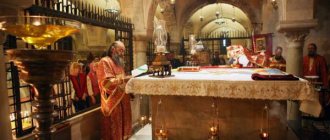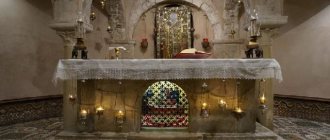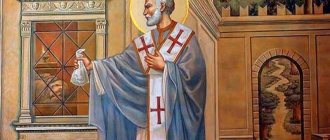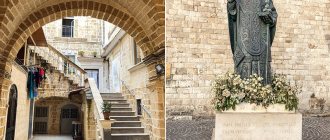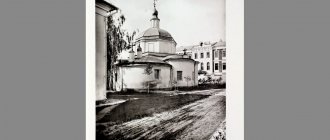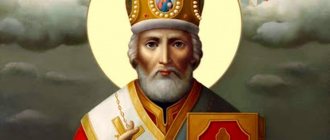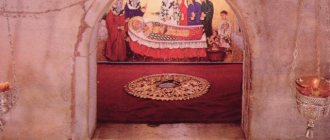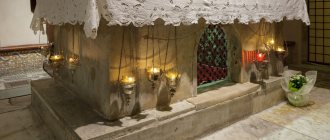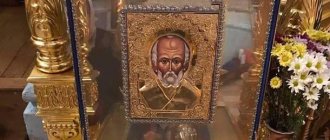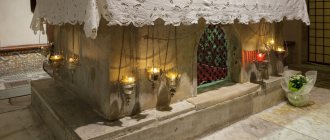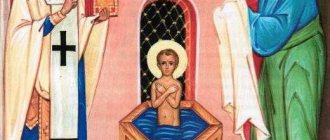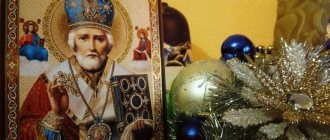Bari is a city on the Adriatic coast of southern Italy known as a place of pilgrimage to the relics of St. Nicholas. Saint Nicholas, like many other saints canonized before the Great Schism of the Church, is revered equally by Catholics and Orthodox.
It is interesting that the relics of St. Nicholas of Myra are simultaneously located in two cities in Italy - in the Basilica of St. Nicholas in Bari and in the Church of St. Nicholas on the Lido Island in Venice. How can this be?
Like the relics of St. Nicholas got to Bari
According to the texts of the first millennium, St. Nicholas (270 - ca. 345) was buried outside Myra Lycia. Pilgrims flocked to the saint’s grave to collect myrrh.
The collection of myrrh continued until the middle of the 11th century, until the Seljuk Turks appeared in the south of Asia Minor. Looting of the Church of Basil the Great in Cappadocia, desecration of shrines, destruction of the Christian population.
In ancient times, a hole was made in the lid of the sarcophagus into which aromatic oil was poured. The oil washed over the relics and flowed out from below through a special hole, from where it was collected in flat cones that were worn on the chest.
Shortly before the First Crusade, the inhabitants of the city of Bari decided to remove the relics of St. Nicholas to his city. Competitors - the Venetians and Genoese - had the same intentions. The Barians arrived first and got the relics of the saint. Although the relic was removed on the second attempt, during the first landing the city was overrun by Muslims and the Barians continued on their way to Antioch.
The Barians did not know where exactly the relics of St. Nicholas and interrogated the monks. As a result, the supposed tomb was discovered by the robbers themselves, by the light of torches in the darkness, they pulled out the relics and loaded them onto the ship.
On May 9 (May 22), 1087, a ship with the relics of St. Nicholas the Pleasant arrived in Bari. This day is mentioned by the Russian Orthodox Church as the holiday of the “Transfer of the relics of St. Nicholas the Wonderworker from Myra in Lycia to Bari.”
To this day, in the Basilica of St. Nicholas, 2/3 of the removed relics are stored. The Venetians did not believe the Barians. There was desperate competition between them for the right to primacy at sea. A few years later, during the First Crusade, Venetian merchants took the remaining fragments of the relics to Venice. So Saint Nicholas became the patron saint of two Italian cities - Bari and Venice.
Nicholas of Myra: miracles of our times
Healed from cancer
The diagnosis of cancer for Oleg’s friend sounded like a death sentence. Examinations carried out in several different clinics showed equally disastrous results - the cancer cells were growing very quickly, and an urgent operation was required, the success of which no one could guarantee.
Then Oleg decided to share with his friend the world brought from the Church of St. Nicholas in Bari. The man advised the patient to lubricate the sore spot with oil and draw a cross on her forehead. Later, from a conversation, I learned that the woman also drank a little of the miraculous oil.
A month after the preoperative tests, the doctors, and along with them the patient herself, learned about the amazing event that had happened. Previously, the steadily multiplying pathogenic cells suddenly not only stopped their growth, but also began to decrease in number. The tumor has shrunk. The woman underwent a successful operation, destroying the remnants of the malignant tumor, and the patient soon recovered.
Sent a doctor to help
Suzanna, as a journalist for Kommersant, was sent on a business trip to Bari. On the eve of departure, the girl, in her haste, seriously hurt her finger on the door. But there was no time to deal with the injury; I had to fly away.
Already in Italy, the finger began to turn black and swell. The girl was scared, literally dizzy from pain. When visiting the Basilica of St. Nicholas, Suzanne, after some hesitation, nevertheless decided to ask the saint not only for the most important, deep things, but also for help with healing the injury. Ashamed of her weakness, the journalist sincerely hoped that the elder would not be angry with her for such an insignificant request, as it seemed to her then.
From Bari the delegation left for Madrid on the same day. Already in the evening the girl’s condition worsened. The tissues completely turned black and the pain became unbearable. At the reception, Suzanne was offered to call a doctor for a fee. The cost of medical care was too high for the girl to afford. With her last hope, she called the Russian Embassy in Madrid and explained her situation. The department immediately offered help and sent a doctor to the hotel.
Seeing the finger, the doctor asked to quickly get ready and go with him, explaining that he needed to do bloodletting. Upon arrival at the embassy, the man quickly did everything necessary. The finger immediately began to look healthy, and the pain began to subside. The next morning the doctor called on Suzanne to change the dressing.
They started talking, and the girl found out that he was a military doctor, worked in Afghanistan, and therefore knows how to behave correctly in emergency situations. Moreover, the man said that Suzanne was literally saved from trouble by a miracle. It turns out that he was going to move to another city, but the embassy asked him to stay behind due to the arrival of a delegation from Russia. Otherwise, a middle-aged doctor from a sanatorium near Moscow would now be in his place. And things might have taken a completely different turn.
Suzanne thanked the doctor and St. Nicholas for everything ending well.
Relieved kidney and bladder diseases
Larisa suffered from chronic pyelonephritis and cystitis since childhood. By the age of 30, the woman’s torment became simply unbearable - the inflammatory processes were constantly worsening, the pain did not allow her to lead a normal human life. Despite the large number of doctors and clinics visited, it was not possible to find a solution to the problem.
The desperate young woman decided to ask the saint for help. Arriving in Bari, she venerated the relics and with tears in her eyes began to pray that St. Nicholas of Myra would help her cope with her illness and start a new, already happy and healthy life.
Returning home, Larisa after some time found a new doctor who prescribed surgery on the urethra. It turned out to be extremely successful - the woman was completely cured of the illnesses that had tormented her for many years. The pain and inflammation never returned.
Tomb of St. Nicholas in Bari Photo from italy4.me
Helped my father recover from a stroke
Tatyana's father suffered a stroke with cerebral hemorrhage. At night, the man was taken to intensive care in extremely serious condition. The right side of his body was completely paralyzed, he did not speak, and soon fell into a coma. The doctors did not even give hope for a positive outcome; they said that even if he survived, he would remain a “vegetable”.
Tatyana and her mother were in despair. For a month they could not find a place for themselves for fear of hearing the worst. Then they decided to call the priest to the intensive care unit so that he could serve a prayer service for health. The priest fulfilled the request and, in addition, advised the women to read the akathist to St. Nicholas of Myra for 40 days.
Over the next days, mother and daughter strictly carried out the order, each time offering the most sincere, most fervent prayers for their loved one. The saint heard their requests - the father came to his senses, his condition improved. After discharge, the man confidently began to recover. After just 1.5 years, he was able to eat independently and walk with a stick. Moreover, the righteous elder made it so that throughout this difficult period not only relatives, but also strangers came to Tatyana’s family, offering all possible help. Together they managed to cope with the disaster.
Saved my daughter from a terrible diagnosis and gave the children to friends
Elena still remembers those days with fear - their 5-year-old daughter was hospitalized with suspected meningitis. The child was in extremely serious condition, the doctors expected the worst. To confirm the diagnosis, it was necessary to take a puncture from the spinal cord. While waiting for the results of this difficult analysis, Elena began with tears, without knowing why, to pray to St. Nicholas the Wonderworker. Later she will say that her mother’s heart probably told her so. The woman with all her heart asked to protect the baby from a terrible illness and promised the saint to come with her daughter to his relics in Bari when the child recovered.
That same night, doctors pleased the family with good news - the terrible diagnosis was not confirmed. The girl simply had a complicated course of ARVI. It was a real miracle that the course of the disease, which in all respects resembled the symptoms of meningitis, turned out to actually be a respiratory infection.
After a while, the baby recovered and Elena and her husband took their daughter, as promised, to Bari to offer prayers of thanks to the saint.
Later, Elena found out that their friends, two married couples, could not conceive babies. Remembering the miracle that Nicholas of Myra performed for them, the woman advised them to go to Bari to ask the saint for children. Previously, unchurched young people initially doubted the need for the trip. However, having learned about the amazing event that had happened in Elena’s life, they decided to travel. It is obvious that the prayers of childless couples were said from the bottom of their hearts, because for some, conception was successfully accomplished two weeks after visiting Bari, and for others, after two months. The women successfully carried and gave birth to healthy children.
Saved a baby's life
Tatyana was being kept in the maternity hospital. Her roommate Maria, after another ultrasound, was diagnosed with problems in the development of the fetus - the child stopped developing at 7 months. The doctors said that the examination results were completely accurate, which meant that labor needed to be induced urgently. The girl was sent to the regional center for a re-examination and further measures. The pregnant woman's condition was serious - she was beside herself with fear for the baby and grief.
Tatyana, who had an icon of St. Nicholas with her, began to pray with all her heart for her friend. As an expectant mother, she perfectly understood her condition and sincerely sympathized.
After some time, the women met again, and from the conversation Tatyana learned that a repeat examination in the regional center showed completely normal fetal development. The child was eventually born on time and completely healthy. Doctors at the regional hospital suggested that the ultrasound machine was simply faulty.
Tatiana told Maria about the icon and how Saint Nicholas averted trouble from her.
Basilica of St. Nicholas in Bari
The basilica was erected in the center of medieval Bari on lands granted to the church by the Duke of Apulia and Calabria, Roger Borsa. The temple was built on the site of the former palace of the Byzantine “governor” from the same stone. The relics of St. were transferred to the church. Nicholas two years after construction began in 1089, although construction continued until 1197.
Since then, the relics of the saint were kept in the crypt of the church until 1951, when, during restoration work, a sarcophagus-reliquary with the relics of Nicholas of Myra was found under the altar.
In 2022, for the first time in the last nine centuries, part of the relics of St. Nicholas the Wonderworker left the crypt for temporary removal to Moscow and St. Petersburg.
Crypt of St. Nicholas in Bari
You can venerate the holy relics on any day, but Orthodox services are held in the church on Thursdays at 10:30, except on fasting days (*information needs clarification). The high grate behind which the altar is located is opened on this day and you can get closer to the relics, see them through the glass window and pray.
Opening hours of the Basilica of St. Nicholas in Bari
The temple is open: daily from 7.00 to 20.30, on Sundays from 7.00 to 22.00
Service times: 7.30, 9.30, 18.30. On weekends: 7.30, 9.00, 10.30, 12.00, 13.00, 18.30, 20.30
Address: Largo Abate Elia, 13, 70122 Bari
By the way, the basilica itself is an interesting example of the Romanesque style. The architecture of the temple has not changed since the 12th century, and the sculptural decoration is even more ancient.
Read more about architecture, history, and relics in the articles Tour of the Basilica of St. St. Nicholas the Wonderworker in Bari
and Tour of the Crypt of St. Nicholas
Saint from Bari. Excursion to the places of St. Nicholas the Wonderworker
Italy. Southern region of Apulia. City of Bari. It is here that the relics of Nicholas the Wonderworker have rested since 1087. This is a great Saint who is known all over the world, and not only by Christians.
Saint Nicholas the Pleasant. Life story
The baby, born in the middle of the 3rd century in the city of Patara (the territory of modern Turkey) in the family of Theophanes and Nonna, was named Nicholas, which translated from Greek means “conqueror of nations.” His parents were pious, rich and noble people, often performing acts of mercy. For a long time, the couple could not have children and prayed for the gift of a child. Their only son, Nikolai, given by God, was raised as a Christian and was distinguished by humility and kindness from a very early age. “At his birth, even in the baptismal font, he stood on his feet for three hours, supported by no one, thereby giving honor to the Most Holy Trinity, a great servant and representative of Whose he was to appear later,” writes St. Dmitry of Rostov.
Later, in his youth, Nicholas spent a long time in church, studying the Holy Scriptures and Tradition, praying and acquiring the grace of God. In his youth he already had the wisdom of an old man. His uncle, also Nikolai, bishop of the city of Patara, watched his nephew, saw his boldness, desire for the Lord, and suggested that Nikolai’s parents give their son to serve God. They listened to the advice and dedicated their child, whom they had been waiting for so long, to the Lord. Nicholas accepted the priesthood.
After the death of his parents, Nikolai distributed their estate to those in need, and also helped his friend who had recently gone bankrupt. This man had three daughters, whom, in a hopeless situation due to poverty, he already wanted to give away to fornication. Nikolai secretly threw one bag of gold coins into a man’s house. With these funds, the neighbor gives his daughters in marriage, thereby avoiding sin. It is with this episode of Nikolai’s life that the tradition of giving gifts for Christmas and New Year is connected. It is believed that Saint Nicholas the Wonderworker became the prototype of Santa Claus.
And Nicholas became the patron saint of travelers and sailors thanks to an incident near Egypt on the way from Lycia to Palestine. Nicholas the Wonderworker sailed there to the holy places in Jerusalem. Suddenly the sky became covered with clouds, and the sea began to be very rough. The saint began to pray fervently and the storm subsided. But the miracles didn't end there. One of the sailors died after falling from the mast. Saint Nicholas prayed to God and the sailor immediately resurrected.
In the Holy Land, Nicholas the Wonderworker thought about leaving for the desert, but was stopped by a Voice from above, which ordered him to return back to his native land. Along the way, the shipmen decided to sail to another area. Nicholas noticed this and begged them to go to Lycia, but they refused to listen to the saint. Suddenly a storm began, which turned the ship in the right direction. So the Pleasant of God returned to Lycia. Here the Voice of God visited him again and ordered him to go serve people. The saint settled in the city of Myra, the capital of the Lycian land, and continued to lead an ascetic life.
When the Archbishop of the entire Lycian country, John, died, all the local bishops gathered in Myra to elect a new archbishop. One of them had a vision: to stand at night in the vestibule of the temple and watch over whoever enters the temple first for the morning service should be installed as archbishop, his name will be Nicholas. And so it happened. So the saint became the archbishop of Myra in Lycia and continued to do good deeds, receiving everyone who needed advice and help.
On December 6, 342, after an illness, Nicholas the Pleasant departed to the Lord and was buried in the cathedral church of the city of Myra (modern city of Demre, Turkey).
History of the transfer of relics to Bari
At the beginning of 1087, Barian merchants sailed on three ships with goods to Antioch (modern Syria). On the way back we sailed to Myra. Forty-seven secretly armed sailors reached the church where St. Nicholas the Wonderworker was buried under the guise of pilgrims. They opened a white marble tomb, which was well preserved by that time. In it, relics were discovered that were in a fragrant world. The kidnappers put them, according to one version, into the brought ark, according to another into outer clothing, and went to their ships. The tomb was heavy and bulky, so they decided to leave it in the temple. There, in the modern city of Demre in Turkey, it is still located. To this day, a large number of pilgrims come to the first burial place of the relics.
On May 9 (22 New Style), 1087, the ship with the shrine arrived at the port of Bari. Here the relics were solemnly greeted by the city residents and clergy. Already from the first days of being in the Apulian capital, many miracles occurred.
The Barians managed to get ahead of the Venetians, their competitors, who also wanted to transport the relics to their lands. Which is not surprising, since the Pleasant of God is the patron saint of sailors. And Bari and Venice are the largest port cities. At the end of the 11th century, the Venetians partially fulfilled their dream. During the crusade, they stole the remains of the relics from the tomb in Myra. In the last century, Italian professor Luigi Martino conducted a study that established the authenticity of the Barian relics and Venetian remains of St. Nicholas.
Basilica of St. Nicholas in Bari
Of course, immediately after the arrival of the relics, the question arose about where to store them. At first, the abbot of the Benedictine monastery Elijah took them under his protection. On October 1, 1089, the lower part of the Basilica of St. Nicholas (crypt) was built. Pope Urban II solemnly consecrated it and transferred the relics here. The upper part was completely built only 108 years later - in 1197.
Altar of the Basilica Interior decoration
The basilica has three naves 39 meters long and is decorated with sculptural decoration, some of which (reliefs, capitals, cornices) were borrowed from more ancient Byzantine buildings. The ceilings are painted with colorful frescoes with gilding, executed by the artist Carlo Rosa di Bitonto in the 17th century. They depict fragments from the life of St. Nicholas.
Basilica ceiling
To the left of the entrance is a full-length sculpture of St. Nicholas the Wonderworker, made of pure silver. One of the most interesting elements is the altar and the ciborium above it in the form of a stone canopy from the 12th century. The capitals of the ciborium are decorated with figurines of angels.
Sculpture of St. Nicholas the Wonderworker
In the underground part of the basilica, as mentioned above, there is a crypt. The reliquary with the relics is located in the very center behind an iron grate. In May, the reliquary is opened, and the rector of the basilica collects the holy myrrh that comes from the relics. Then the myrrh is diluted. It can be purchased at the church shop near the basilica. It has healing properties. There is also a museum next to the church; its collection contains precious art objects.
Cancer with relics
On Tuesdays and Thursdays, Orthodox Christians have a wonderful opportunity to attend the liturgy in the crypt near the relics of St. Nicholas the Wonderworker. At 10 o'clock confession begins, and at 10:30 the service itself begins, and then the akathist to the saint is read. Upon completion, you can venerate the relics of the Saint.
In 2003, a monument to St. Nicholas the Wonderworker by Zurab Tsereteli, donated by the President of our country, was erected on the square next to the basilica. On the bas-relief at the monument it is written:
"PRESIDENT OF RUSSIAN FEDERATION
Residents of Bari
Dear residents of Bari
I am glad to have the opportunity to cordially greet the residents of the ancient Italian city of Bari. I am especially pleased to do this, since your land and Russia are connected by ties of centuries-old history. A monument to this miracle worker is given as a gift to your city, which holds the great Christian shrine - the relics of St. Nicholas, Archbishop of Myra in Lycia.
Saint Nicholas is one of the most revered saints. But it is in Russia that he enjoys special respect. The altars of many Russian churches are consecrated in the name of St. Nicholas. Let this gift testify not only to Russians’ veneration of the holy ascetic, but also to the constant desire of the peoples of our countries to strengthen friendship and cooperation.
V. Putin"
Statue of St. Nicholas
Metochion of the Russian Orthodox Church
Literally a 30-minute walk from the Basilica of St. Nicholas and a couple of minutes from the station is the Patriarchal Compound of St. Nicholas the Wonderworker in the city of Bari of the Russian Orthodox Church.
bas-relief of Elizaveta Feodorovna
At the entrance to the courtyard building there is a bas-relief with the following inscription:
“In memory of Grand Duchess Elizabeth Feodorovna Romanova, nee Princess of Hesse (1864-1918), the second Chairman of the Imperial Orthodox Palestine Society, under whose patronage the Metochion of St. Nicholas was erected in Bari.”
She rightfully became a key person in the history of the courtyard.
Nicholas the Wonderworker has been revered by Orthodox Christians since ancient times, and Russian pilgrims have visited the city of Bari since the 15th century. In this regard, the idea arose of building a metochion of the Russian Orthodox Church near the relics of St. Nicholas the Ugodnik.
The Imperial Orthodox Palestine Society (hereinafter referred to as the IOPS - author's note) on May 12, 1911, according to the old style, established the Bargrad Committee with the support of Emperor Nicholas II. Before the committee headed by the expert on ancient Russian art, Prince A.A. Shirinsky-Shikhmatov, were given the task of erecting a courtyard for Russian pilgrims and with a church that would reflect Orthodox culture.
In October 1911, the Italian government allowed the IOPS to purchase a plot of land in the city of Bari. The project of the courtyard was developed by the architect A.V. Shchusev (who built the Marfo-Mariinsky Convent in Moscow for Elizaveta Feodorovna in 1908–1912). The courtyard included a temple for 200 people, a house for pilgrims, a ward for the sick, a refectory, a washroom, a laundry and a bathhouse.
On May 22, 1913, the ceremonial foundation stone of the courtyard took place. In December of the same year, a temporary house with a belfry and an upper room for a temporary church was consecrated. During the First World War, construction work continued and was completed by 1915. The Italian Red Cross was also allowed to settle here to help the wounded.
During the period of the revolution and civil war in Russia, the farmstead was in difficult conditions. The local community had not yet formed, and pilgrims, for obvious reasons, rarely came. As a result, the entire territory and buildings of the farmstead became the property of the authorities of the city of Bari.
Only in the late 1990s did the city authorities transfer the upper church of the courtyard (St. Nicholas) to the Moscow Patriarchate for use. However, the farmstead itself was still owned by the Bari authorities. This served as an obstacle to the development of pilgrimage and the fulfillment of the original purpose of building the farmstead. At the end of 2008, with the assistance of Patriarchs Alexy and Kirill, as well as Vladimir Putin, an act of transfer of the architectural complex to Russia was signed.
Processed with VSCO with hb2 preset
The courtyard was built in the Pskov-Novgorod style. The church building consists of two temples. Lower in the name of St. Spyridon of Trimifuntsky. The top one is in the name of St. Nicholas the Wonderworker.
Today, the territory also houses a pilgrim's house, a refectory and a small garden. It's very cozy here.
Services in the temple are held almost every day, with the exception of Tuesday and Thursday. These days the service takes place in the crypt of the Basilica.
icon of the Pleasant of God on the street of Bari
Since the relics of Nicholas the Wonderworker were brought to Bari, the saint became the patron saint of the capital of Apulia. City Day is celebrated here on the day of the transfer of the shrine from Myra Lycia - May 9. On this occasion, solemn celebrations are held. Icons, monuments and frescoes depicting the Pleasant of God can be found on almost every street, in shops, cafes, restaurants and residents’ homes. The saint, with his miracles and mercy, rightfully won honor and respect not only among the Apulians, but also among many Christian denominations, and to this day he comes to the aid of the needy and suffering. And according to the Charter of the Russian Orthodox Church, this great archbishop of Myra of Lycia is remembered every Thursday.
Relics of St. Nicholas the Wonderworker in Venice
Several years have passed since the theft of the relics of St. Nicholas by the Barians, just as the Venetians decided to prove that they would be the ones to own the relics. Venetian merchant knights during the First Crusade around 1099-1101. went ashore at Myra Lycian and forcibly removed the supposed remains of the relics, mostly small fragments.
Did the Venetians act so brazenly and confidently out of stubbornness? Of course not. The fact is that a couple of centuries before the famous events, the Byzantine Emperor Vasily I ordered the transfer of part of the saint’s relics to Constantinople.
For this purpose, a copper casket was made and the relics were prepared for transportation. However, the emperor had a vision, allegedly of St. himself. Nicholas appeared and forbade the transfer of his relics. The Venetian merchant knights and pirates knew that this casket with part of the relics was hidden in a certain place in the temple in Myra.
So, one fifth of the relics of St. Nicholas the Wonderworker rests in the Catholic basilica of the same name on the Lido island in Venice.
Basilica of San Nicola in Venice (source: Wikipedia)
Basilica of St. Nicholas - architecture
The architecture of the temple is very original - it contains mainly rectangular elements and straight lines, which is more appropriate for castles or fortresses. The impression is enhanced by two massive towers at the edges of the facade. However, the church still had to withstand siege several times, so appearances are not entirely deceiving.
Perhaps the only external decoration can be called carvings from the 12th century. on the entrance portal. The columns supporting the portico are supported by figures of bulls, and in the lunette you can see a relief with a triumphant man on a chariot. The building's pediment is crowned with a sphinx. The building may have originally been more picturesque, but during reconstructions in the 13th, 15th and 17th centuries, some of the decoration was removed.
The temple has three naves 39 m long, a shorter transept - 31.5 m. All naves end with apses, about which there is practically nothing on the outside - they are hidden by straight walls with false arcades. During the renovation of the building in the last century, the interior lost most of the Baroque elements, retaining only the vaulted wooden ceiling of the transept, decorated by the artist Carlo de Rosa. The central image here is dedicated to God the Father, around whom the patriarchs are located.
Basilica of St. Nicholas - relics of St. Nicholas the Wonderworker
Basilica of the Holy - Divine Service
Basilica of San Nicola on Lido Island
Relics of St. Nicholas are in the basilica of the 9th century in the shrine above the throne. In addition to the relics of the saint, the relics of the Hieromartyr Fyodor and St. Nicholas, called “uncle,” are buried here. The Venetians took all these relics from Myra Lycia at the same time.
Unlike the Basilica of St. Nicholas in Bari there is no mass pilgrimage to the island of Lido. The Church of San Nicola is visited by single tourists, and the opening hours are quite limited, so the caretaker’s phone number is posted at the entrance, just in case.
Opening hours
Basilica opening hours: Monday to Saturday 8:00 – 12:00, 15:00 – 18:00
How to get there: from Piazza San Marco to Lido SME take vaporetto no. 1 and others, travel time is 15 minutes.
Address: Riviera S. Nicolò, 26, 30126 Venezia VE
Interior
The interior of the basilica is divided into three naves, ending with apses. The width of the central nave is twice as wide as the width of the side ones. The main altar of the Basilica of St. Nicholas, as well as the ciborium covering it, date back to the first half of the 12th century.
Altar and ciborium
In the temple you can see the original Cathedra Eliei, made from a single piece of marble and one of the masterpieces of Romanesque Apulian sculpture. The pulpit is located behind the ciborium, in the central part of the presbytery.
Behind the Cathedral is the funeral monument of Bona Sforza - Duchess of Bari and Queen of Poland, made in the 16th century.
The altar of the right apse is decorated with a 15th-century triptych by Andrea Rizo da Candia. In the apse of the left nave there is an altar decorated with a canvas depicting the Madonna and Child enthroned and Saints Giacomo, Ludovico, Saint Nicholas and Marco by Bartolomeo Vivarini from 1476.
Anthropologists about the relics of St. Nicholas the Wonderworker
The first anthropological studies of the relics in Bari were carried out by Professor Luigi Martino in 1953. At the same time, the fact of myrrh-streaming was officially recognized.
Only in 1992 did scientists gain access to the relics of the saint in Venice. Professor Martino put the final point in the research:
“...the white bones located in Venice complement the remains preserved in Bari.”
The relics in Bari and Venice belong to the same person.
Monument to Nicholas the Wonderworker on the square in front of the basilica from Zurab Tsereteli
An anthropology professor found that both bones belonged to the same man who lived during the Roman era, who died at the age of just over 60 years. The man ate vegetarian food, spent part of his life in a damp room and looks like a man similar to the image on the icons. It is known that St. Nicholas lived for some time in prison.
This is where the story about St. Nicholas the Wonderworker ends and moves into the question of Faith, which each Christian determines for himself individually
What to pray for before the relics of St. Nicholas of Myra
Knowing about the saint’s gift to heal from the most terrible illnesses, believers offer him prayers for miraculous deliverance from ailments. The holy elder invariably heeds sincere spiritual prayers, rewarding everyone according to his faith.
In addition, during his lifetime the saint was famous for his desire to find truth and justice. Without sparing himself, he fought against dishonest people, protecting the innocent. Knowing this, they turn to the Wonderworker with prayers for protection from spiteful critics and liars who seek to denigrate a person’s good name before people.
You can also turn to the saint with prayers for help in the most difficult, hopeless situations. And also that we always have our daily bread.
Finally, we should not forget that Nicholas the Wonderworker is the patron saint of children. Therefore, believers always turn to the saint with prayers for the protection of their children from troubles, misfortunes, illnesses and everything bad.
Who is Nicholas the Wonderworker
The first information about Bishop Nicholas of Myra began to spread at the end of the 5th - beginning of the 6th centuries. Acts of St. Nicholas were recorded in Myra Lycian in the south of Asia Minor and quickly spread throughout Byzantium.
Since the 9th century, the first life of St. Nicholas of Myra with mention of such facts from life as refusal of inheritance, helping the poor, saving girls from debauchery. Further, miracles with sailors, a miracle with the election to a bishopric, a miracle with imperial grain, and so on.
The Life was written in the style of high rhetoric for an educated public, rewritten, distributed and expanded. Later it was discovered that the life of St. Nicholas of Myra is a mixture of information about two separate individuals.
The fact is that in the 6th century there lived another Nicholas of Pinarsky or Zionsky. He founded a monastery in honor of Saint Zion. He also came from a poor family and helped the poor and needy. The life of this saint has been well studied and known.
It so happened that there were white spots in the life of St. Nicholas of Myra were filled with scenes from the life of St. Nikolai Pinarkiy and so their biographies are mixed.
Be that as it may, by the tenth century the clergy had revised the life of St. Nicholas of Myra into a single text, sanctified it and became the basis for painting icons.
In the 19th century, the Byzantine scholar, head of the Russian spiritual mission in Jerusalem, Archimandrite Antonin Kapustin, saw inconsistencies in the sequence of historical events in the life of the saint. He discovered the second Nicholas - Zionsky and unraveled the whole mystery.
Icons of St. Nicholas from Bari
Veneration of St. Nicholas of Myra in Rus'
In Rus', the veneration of saints begins no later than the 11th century. Already in Kievan Rus the round image of St. Nicholas the Wet was revered. A little later, the name Nikolai appears in the princely dynasty as the second baptismal name.
Since the beginning of the 12th century, veneration has spread in Novgorod, which is associated with the construction of the St. Nicholas Cathedral around which bargaining arose. So Nicholas the Wonderworker becomes the patron saint of traders and merchants, being already the patron saint of travelers and sailors.
St. Nicholas churches are widespread in Rus', perhaps not without the participation of the Normans, who ruled in the south of Italy in the 11th-12th centuries.
The first temple after the Mongol invasion was built in Nikolsky, Nikola on Lipna.
Over the centuries, local cults have appeared associated with local miracles that were attributed to Nicholas the Wonderworker, legends, local images of Nicholas, for example: Nicholas of Mozhaisky.
In the end, Nicholas becomes a Russian saint, having lost his Greek image, but this is already the realm of folk culture.
The Day of Remembrance of St. Nicholas the Wonderworker, which is celebrated in winter (December 19), is called the Day of St. Nicholas the Winter. This “winter” image of the saint depicts him with a miter, the headdress of a priest, on his head.
Bari - history
Center of the city of Bari
Historians find it difficult to name the exact age of Bari, but suggest that already a thousand years BC. there was a settlement here.
Today, the ancient settlement has become a large city, the number of residents of which exceeds 325 thousand people. Bari is the administrative center of the region of Apulia.
In the 3rd century. BC. this part of modern Italy entered the Roman Empire as a municipality (a city whose population received partial self-government and civil rights). A theater was built here, temples were erected, but archaeological evidence of this could not be found.
The structure of the old city that exists to this day was formed in the middle of the 5th century AD, during the struggle between the Eastern Roman Empire (with its capital in Byzantium) and the Lombards. In those years, special administrative units, cathepanates, were formed, which were controlled by the leaders of provincial military detachments.
Later, the city experienced the domination of the Barbers (Arab peoples from northern Africa), the subjugation of Bevenento (a large duchy in the northeast), the siege of the Saracens, the invasion of the Venetians...
A major shock was the uprising of Melus in the struggle for independence from the Byzantines in 1009. It led to the plunder of Bari (and part of Italy) by Norman troops called to help the rebels.
What do St. Nicholas and Santa Claus
The history of the veneration of St. Nicholas is very diverse. The saint's feast day was celebrated in December. On this day, children were given gifts on behalf of the saint, and bakers, whose patron was St. Nikolai, they distributed baked goods to the poor and sick.
In the West, Nicholas the Wonderworker was often depicted with three bags, as an association with the three bags that the saint threw to the bankrupt rich man to save his daughters from fornication.
However, during the Reformation, the veneration of saints was temporarily stopped, and the tradition of giving gifts was delegated to the infant Christ. Gifts have already been given for Christmas.
But again a miracle happened and St. Nicholas firmly entered the lives of Europeans, and the Dutch, who set off to conquer North America, took away their love for St. Nicholas with you. In their language, the name of the saint sounds like Sinterklaas, but the more euphonious Santa Claus has taken root. There he looks like a kind old man who gives gifts at Christmas, brought in bags or socks.
Interesting Facts
- The ancient city of Myra is now the modern city of Demre, Antalya province.
- Unlike the Greeks, who mourned the movement of bones, in Russia they began to celebrate this day as the discovery of relics.
- After the Blessed Virgin Mary, Nicholas the Wonderworker is considered the most revered saint in Russia.
- Memorial Day of St. Nicholas is celebrated twice a year - in winter and summer.
- On the icons, St. Nicholas the Wonderworker is depicted with an episcopal miter or with his head uncovered, which corresponds to the folklore representations of “St. Nicholas of the Winter” and “St. Nicholas of the Spring” (summer).
- Before the reforms of Patriarch Nikon, it was sacredly called Nikola or Mikola.
- Miro or “manna” from the relics of St. Nicholas is collected in Bari once a year on May 9.
Sources: basilicasannicola.it, foma.ru and other printed literature.
Saint Cancer
The tomb of St. Nicholas is austere, like a pagan altar. The Holy Relics of the Saint (about 75 percent) are located below floor level and are covered on all sides with reinforced concrete blocks. The absence of the remaining bones of the skeleton is explained by the fact that the Barian sailors were in a hurry for fear of the arrival of the Saracens, and therefore took the largest bones. The missing part of the Holy Relics is located in various churches around the world, primarily in Venice.
ECCO IL VIDEO CHE MOSTRA LE RELIQUIE DI SAN NICOLA
